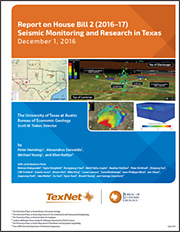Synopsis: Development of earthquake ground shaking relationships for earthquakes in Texas
Project Status: active
Funding Source: 100% CISR IA
Research Leaders: Ellen Rathje, George Zalachoris
Project Start: 1Q2016
Project Interface: Project interfaces closely with Texas Seismicity Studies, Ft. Worth Basin Earthquake Characterization, Seismic Hazard and Risk Assessment - Shear Wave Velocity Characterization, Seismic Hazard and Risk Assessment - Building Infrastructure, Basin-Scale Assessment of Fault Reactivation and Seismicity Potential, Theoretical Analysis of Controls on the Size Earthquakes Induced by Fluid Injection, and Seismic Risk Social Science
Expected research outcomes:
- Database of engineering parameters of ground shaking from earthquake recordings
- Characterization of near-surface site conditions at earthquake recording stations
- Empirical relationships that predict engineering parameters of ground shaking as a function of magnitude, distance, and site conditions
Given the potential for earthquakes, seismic hazard and risk assessment provides a rational approach to evaluate potential adverse effects (e.g., damage, economic losses) from such events. Research is needed regarding the appropriate ground shaking relationships for earthquakes in Texas and Oklahoma and the seismic characterization of the near-surface geomaterials.
The damage potential from earthquakes is related to the ground shaking generated. The shaking from earthquakes in low seismicity regions such as Texas may have different characteristics than other regions owing to differences in the source depth and other source characteristics. Additionally, the regional/local geology and soil conditions can significantly influence ground shaking. Investigating shaking in Texas and Oklahoma within a framework of the related geologic conditions is important for properly quantifying seismic risk.
The proposed research involves the development and analysis of an extensive database of recorded earthquake motions from Texas and Oklahoma. The database development will include processing (i.e., filtering, baseline correction, etc.) of recorded motions and compiling various ground motion parameters that are used in engineering analyses (e.g., peak ground acceleration, peak ground velocity, response spectral values, duration). Near-surface site conditions play an important role in the intensity of ground shaking, and can be quantified through the average shear wave velocity over the top 30 m of a site (Vs30). Vs30 values will be estimated at each recording station using the P-wave seismogram method, and some sites will have Vs30 directly measured in the field under the Shear Wave Velocity Characterization project lead by Brady Cox. The database of ground shaking and Vs30 will be made publically available. The analysis will include statistically comparing the ground motion parameters with those from other regions, including active continental regions (e.g., California) and stable continental regions (e.g., New Madrid Seismic Zone, central and eastern Canada). This analysis will help us assess whether earthquake motions in Texas and Oklahoma are similar to those from other regions. This information is important to properly model the intensity of shaking and damage potential in seismic hazard analyses and risk assessments.
